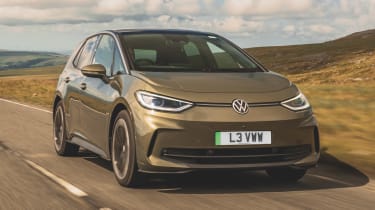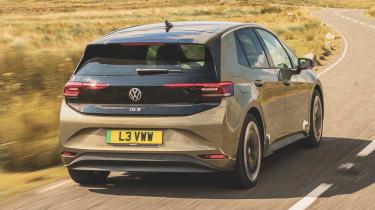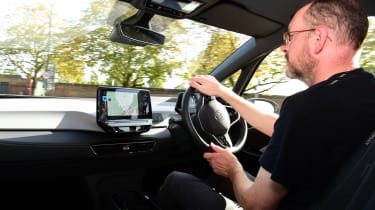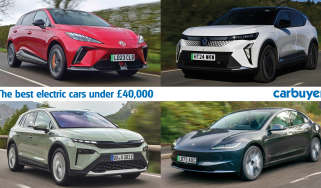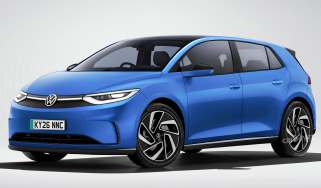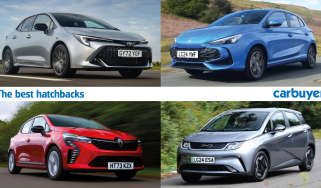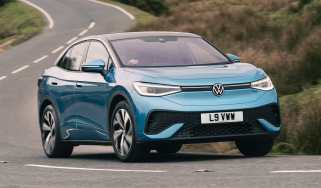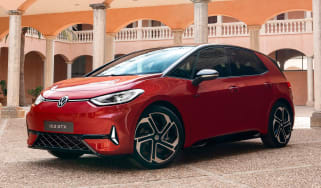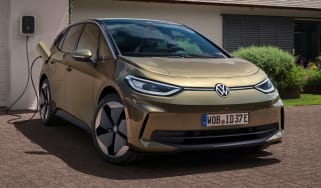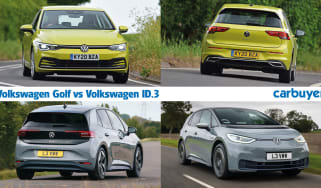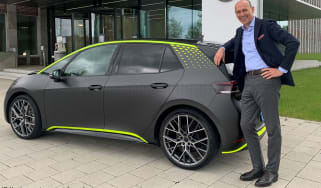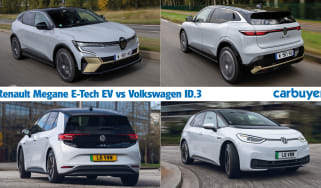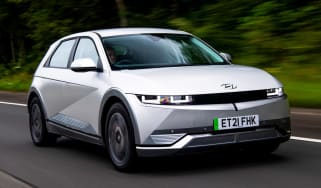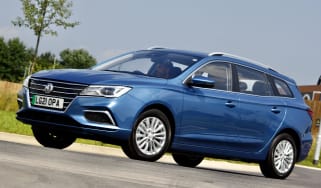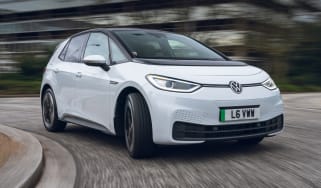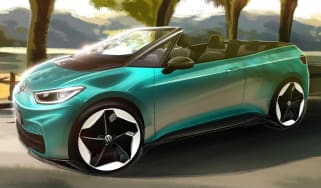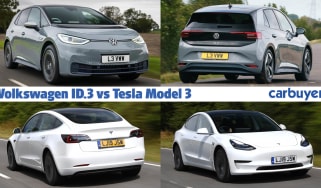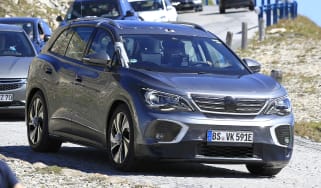Volkswagen ID.3 review - solid EV, but infotainment lets it down
"The Volkswagen ID.3 is a strong EV contender that’s good to drive, practical and has a decent range, and now there’s a sporty GTX model too"
Pros
- Performance
- Range and fast-charging
- Interior space
Cons
- Infotainment tech not up to scratch
- No one-pedal driving
- Top-spec cars four-seat only
Verdict – is the Volkswagen ID.3 a good car?
The Volkswagen ID.3 is a great car for families wanting to make the switch to electric motoring, and doubly so now the maker has implemented some critical mid-life updates to improve interior quality. This, added to a simplified (and cheaper) model lineup makes the ID.3 easier to recommend than ever before; impressive performance, good electric range and fast charging, plus a generous kit list and a roomy interior make the electric VW a viable alternative to petrol hatchbacks and SUVs. We’re also feeling much better about the car thanks to VW’s 2024 updates to the infotainment system, which was a serious flaw in the older cars.
Volkswagen ID.3 models, specs and alternatives
The Volkswagen ID.3 was the first fully electric car from the German brand not to be based on an existing model, so it marked an important milestone. There are a lot of benefits to designing an electric car as such from the outset, such as the ability to offer more space and practicality without a bulky engine. It also helps to accommodate a larger battery and thus provides a longer range. Coming before the ID.3, the brand’s e-Golf was heavily based on the standard petrol and diesel-powered Golf, offering a limited driving range as a result.
Volkswagen’s production of the ID.3 is also carbon-neutral, thanks to steps it has taken to reduce the footprint of its manufacturing, which should give you peace of mind knowing that it’s eco-friendly when it hits the road. As it’s such an important car for the brand, Volkswagen is keen for the ID.3 to prove a success. Its striking, futuristic design is intended to tout its status as a car leading the brand in a new direction but could be considered quite a polarising look for fans of more traditional styling.
 The 10 best electric cars in 2025
The 10 best electric cars in 2025
This was tweaked slightly for 2023, with black elements of the bonnet now body-coloured, and a new bumper design that’s also more aerodynamic, along with updated exterior lighting. It was inside, however, where the biggest updates can be found; Volkswagen has fitted much more premium-feeling materials, finally befitting of the car’s £35k-plus starting price. In 2024, VW also added a GTX model, the electric equivalent of the maker’s GTI petrol range. It gets a high level of specification, and a useful boost in power over the standard ID.3.
The minimalist cabin has a neat design, and the addition of an improved 12.9-inch infotainment screen in 2024 has fixed many of our bugbears with earlier cars and their 10-inch screen. The size doesn’t make much difference, but the newer setup is much less glitchy and has fewer delays between screens. One of our biggest frustrations, though, is the touch-sensitive climate control sliders beneath the main screen. They’re fiddly to use, but at least since 2024 they’ve been backlit – in earlier cars they weren’t, which made them a real nuisance to use at night.
VW now offers 52kWh, 58kWh and 77kWh options in the regular ID.3 range, and a 79kWh pack in the sporty GTX. The 58kWh capacity offered in the Pro can manage up to 265 miles on a single charge, while the 77kWh battery in the Pro S manages up to 347 miles and the GTX’s slightly larger pack a claimed 375 miles. All three can charge from 10% to 80% in around half an hour. Added in November 2024, the smallest 52kWh battery has a range of around 240 miles.
The Pro and Pro S names not only define which battery you get, but what other kit your car comes fitted with. Base versions get 18-inch steel wheels, LED lights and two-tone paint with a contrasting black roof, while inside there’s a 12.9-inch screen and a digital instrument cluster. Pro S versions cost around £3,000 more and get larger 20-inch wheels and better seats – plus that bigger battery and longer range. The GTX gets some subtle styling tweaks outside and a set of sportier front seats inside, as well as a sports steering wheel and the now-obligatory red stitching.
Entry-level versions can now be had with a 168bhp electric motor, while middle of the range ID.3 comes with a 201bhp rear-mounted, rear-wheel-drive electric motor. Opt for the ID.3 GTX though and you get a notable bump in power, with a 322bhp motor mounted at the rear axle – more power than you get in a Golf GTI.
Acceleration was impressively brisk even in our Pro-spec test car. For most buyers, this level of performance (0-62mph takes 7.4 seconds) will be more than sufficient – putting the Nissan Leaf and Kia Niro EV in the shade. In fact, on performance alone, rivals like the MG4, Cupra Born and Renault Megane E-Tech are probably more worthy of mention. The GTX naturally takes things a step further, with its claimed 0-62mph time of 5.9 seconds, but despite being the quickest ID.3, performance is a little underwhelming for a sporty model – an MG4 XPower is more than two seconds quicker.
Around town and away from traffic lights, the ID.3 feels quicker off the mark than most other traffic. Despite weighing more than a Golf, the ID.3's low centre of gravity also makes it remarkably agile, beating the petrol or diesel Golf in this regard. A tight turning circle is also an unexpected bonus of the extra space under the bonnet, giving the ID.3 an advantage in city streets and car parks.
Even on big 20-inch alloy wheels in high-spec cars, on the vast majority of roads ride comfort is commendable. The 18-inch wheels fitted to most cars should improve comfort further. It’s generally quiet on the move too, which is handy as the lack of an engine increases your awareness of other sounds.
Volkswagen ID.3 long-term test
November 2023 update, Andy Pringle – Carbuyer contributor
We're spending several months driving a Volkswagen ID.3 Pro S 77kWh to experience the car in the real world, and over the course of a British winter. It arrived on our fleet in September 2023, and we've already amassed a few thousand miles in the EV, which has a list price of £42,870 – and £51,000 after optional extras are factored in. The most important of these is a heat pump, which should improve its cold weather efficiency by heating the cabin using less energy. So far, we're impressed with the car's styling, but not fully sold on its laggy infotainment, or convinced the interior lives up to the car's price tag.
Contributor Andy Pringle had only just remarked how easily the newly arrived ID.3 had slotted into life as Dad’s Taxi in London. But the car’s biggest test yet came with a journey to visit his family on the Sussex coast. It’s a round trip of about 160 miles, but with charging impossible at the family home, Andy was hoping to do the whole journey without needing to use a public charger. In theory, it was well within the car’s abilities, but given that much of the journey would be at motorway speeds, and Andy had lots of short trips to do in Sussex, he was concerned as he set out.
In the end, the car did a great job. The trip computer showed a 347-mile range as he left, and on his return, it still showed 45 per cent of the charge left, and a range of 142 miles. An overall return of 3.8mi/kWh translates to an impressive real-world range of 316 miles.
